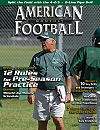Article CategoriesAFM Magazine
|
Coach to Coach: The Pre-Season Home Stretch© More from this issue“The time will come when winter will ask what you were doing all summer.” Two months and counting! It is amazing how fast the season is approaching. By the start of June, our players have completed countless workouts, 10 days of spring ball and now are preparing for summer camp at the University of Nevada. We have spent the last few months training and preparing ourselves for the 2011 season. June is the start of the final phase of the so called off-season. What we do over the next 10 weeks will have a direct impact on our success this season. As a coaching staff, we have spent years trying to perfect our summer sessions and fall camp schedule. As the head coach, my primary objective is to ensure that we are getting the most out of our players in the areas of physical a....The full article can only be seen by subscribers.
|
|
|||||||
| HOME |
MAGAZINE |
SUBSCRIBE | ONLINE COLUMNISTS | COACHING VIDEOS |
Copyright 2025, AmericanFootballMonthly.com
All Rights Reserved





